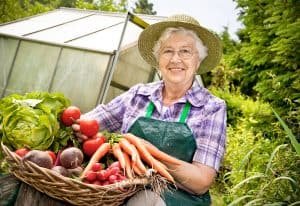August is a good time to do some digging… in the garden, that is. If you have yet to rid your garden of old plants, now is the time to do so. Make some space for the crops to plant now for fall harvest.
[lookbook id=”78929″]
Arugula
Arugula is a leafy green vegetable known for its unique, peppery flavor. It’s often added to salads to give it some crunch while also lending its distinct flavor. Healthwise, arugula is rich in nutrients such as phytochemicals, fiber, calcium, potassium, folate, and vitamins A, C, and K. Some known health benefits include enhanced bone and tooth health, better heart and nerve functions, improved muscle contraction, and low blood pressure. The powerful antioxidant is also high in cancer-fighting agents but low in sugar, fat, calories, and carbohydrates. Oh, and it helps freshen sour breath.
Arugula thrives in the Central, Midwest, North Central, and Pacific Northwest regions. They’ll also grow well in the Mid-Atlantic, North Central, New England, and Rocky Mountains regions.
Arugula is ready for harvest in about 40 days after planting the seeds. If you plant them this August, they should be ready by late September to mid-October.

Basil
For people who love Italian cooking, basil needs no introduction. It’s a popular herb used in pasta, pizza, sauce (especially pesto), soup, salad, and even as an ice cream topping. You can even steep it to make basil tea, which is great if you want to fully enjoy its medicinal benefits.
The nutrient-dense herb is loaded with vitamins A, C, and K. It’s also an excellent source of calcium, magnesium, iron, manganese, and omega-3 fatty acids. Basil is used to treat colds, nasal passages inflammation, appetite loss, intestinal gas, stomach spasms, worm infections, and snakebites.
Basil is quite easy to grow. You can plant them directly in your garden or, better yet, start a container garden. The herb can grow in many climates but if you reside in the Southwest, Southeast, or Gulf Coast Region, you can plant your basil seeds this August and expect a fall harvest. It’s ready to be harvested in as short as three to four weeks after planting. That means you can enjoy fresh basil leaves early next month if you plant the seeds right at this moment. Well, maybe later after you read this.

Beets
Beets are examples of root crops to plant now for a fall harvest. They can be eaten raw (peel the skin first), pickled, roasted, pureed, grilled, and broiled. The fast-growing root crops are rich in vitamins and minerals along with pigments and inorganic nitrates.
Beet helps boost the body’s immunity, protect against heart disease, cleanse the colon, and improve gallbladder and liver functions. The vegetable can also be used to treat acne, boils, and abscesses.
Late summer is the ideal time to start sowing beet seeds. Pre-soak the seeds to prepare them for germination and then sow them outdoors. Plant them behind taller crops to prevent direct exposure to the sun. Once the temperature lowers, remove the taller crops so the beet will thrive more.
Beets can be grown almost anywhere. They will surely thrive in the Central, Midwest, New England, and the Mid-Atlantic Regions, as well as in North Central U.S., Rocky Mountains, Pacific Northwest, Southeast/Gulf Coast Region, and the Southwest.

Broccoli
Broccoli is another crop that you can plant now in time for fall harvest. It grows fast and is capable of providing two harvests in a single season as long as you plant it early.
Broccoli is high in fiber, protein, and vitamins A, C, E, K, and a variety of B vitamins, including folic acid. It also has lots of iron, potassium, calcium, magnesium, and selenium. It helps boost your immune system, aid in digestion, improve bone health, reduce inflammation, and lessen the risk of cancer.
Your broccoli has a better chance of thriving this August if you live in the Central U.S., Midwest, New England, and the Mid-Atlantic Region, Pacific Northwest, and the Southwest.

Carrots
Bugs Bunny likes them carrots raw. Carrot sticks are indeed pretty great as snacks, especially when you’re on the trail. They also go well as part of a salad or as an ingredient in stews and other dishes.
Carrots are rich in vitamin A and beta-carotene, which supposedly lessens the risk of diabetes.
They also contain fiber that can help maintain your blood sugar level. The calcium and vitamin K in these vegetables also help strengthen the bones.
Carrots can be harvested around 70 to 80 days after planting. Check the top of the root first. Some carrots can be harvested once they reach about 1/2 inch in diameter. Other varieties grow as wide as 1 1/2 inches in diameter.
Carrots are best planted during this time in the Central U.S./Midwest, New England, Mid-Atlantic region, Pacific Northwest, Southeast/Gulf Coast, and the Southwest region.
[lookbook id=”78931″]
Corn
Corn is usually planted after the last frost in spring. But if you want the sweet corn variety, you can still plant it this August, especially if you’re in the Southwest. It normally takes a couple of months to mature so it should be on time for fall harvest.
Why plant corn, you ask? Well, you can never go wrong with grains. They are packed with vitamins and minerals and provide health benefits such as better digestive health, prevention of hemorrhoids and colorectal cancer, less risk of anemia, lower LDL cholesterol, improved eye health, and a healthier heart. If you still have doubts about sweet corn being a healthy crop, you should know that you only get 6 to 8 grams of sugar for every cob of corn.
Cucumber
Cucumbers are fast growers. It takes only 50 to 70 days from planting for you to harvest these fleshy vegetables. If you live in the Southwest, Southeast, or Gulf Coast regions, you can plant cucumbers this August and expect a fall harvest (sometime between October and November). Make sure the ground has thawed before planting your cucumbers if you want them to thrive and produce an excellent harvest.
Cucumbers contain antioxidants along with important vitamins and minerals. They help in weight loss and regularity. Cucumbers also aid in lowering your blood sugar levels and improving bone and skin health. The electrolytes in cucumbers also help prevent and treat dehydration. It is also believed that these vegetables can help against diabetes and cancer.
Cucumbers are perfect for salads, smoothies, dips, and even soups. Add them to your sushi, too. Of course, you can pickle cucumbers, as well. You can also eat it without cutting as they did in My Neighbor Totoro. You just have to wash it thoroughly before taking a bite.

Dill
Dill is a culinary herb that has a fresh, citrus-like flavor with a hint of sweetness and grassy undertone. It is often used as a garnish for soups, salads, and roasted vegetables as well as an additional flavoring for chicken, lamb, fish, and egg dishes.
The herb is rich in vitamin A, vitamin C, folate, fiber, calcium, magnesium, and antioxidants like flavonoids. It helps protect the body from cancer, stroke, and heart disease.
Dill can be planted anytime including this August. You can harvest the leaves over and over until the plant starts flowering. To keep a regular supply of the fast-growing dill, plant a new batch before the current one starts flowering.

Tomato
Tomatoes are one of the most versatile fruits (or is it a vegetable?) in this list of crops to plant now for fall harvest. You can eat it raw (wash thoroughly, though), use it as an ingredient in cooking, and turn it into lots of other stuff like tomato paste, sauce, puree, juice, and ketchup. You can make canned tomatoes and sun-dried tomatoes, too.
Tomatoes are rich in nutrients, too. It is packed with vitamin C, vitamin K, folate, potassium, and lutein. It is also high in lycopene, a powerful antioxidant that protects the eyes from light-induced damage and supposedly lessens the risk of cancer and heart disease.
Tomatoes also keep blood pressure and blood glucose at healthy levels, especially in diabetic people. Their high water and fiber content also keep you hydrated while also helping treat constipation.
Tomatoes grow quickly in most locations and are harvested before fall. You can still plant your tomatoes in August, especially if you’re in the Southwest.

Turnips
Turnips are a simple vegetable to cultivate in fall and winter gardens. They’re usually added to soups, stews, and other dishes. Both the root and the leaves of turnips are edible.
Plant turnip their seeds directly on the soil around late summer to early fall. They’ll be ready for harvesting in 40 to 60 days. By then, their roots should have started to emerge from the soil line.
Turnips are packed with fiber, protein, and omega-3 fatty acids along with vitamins A, C, E, K, B1, B2, B3, B5, B6, and folate. They’re also rich in minerals such as calcium, copper, iron, magnesium, manganese, phosphorus, and potassium.
Since turnips are high in potassium, these root crops help take care of the nerves, muscles, and heart. They aid in preventing stroke and high blood pressure. Turnips also offer medicinal benefits against eye problems, high blood sugar, brittle bones, kidney stones, and cancer.
There are a few places where you can plant turnips this August, particularly, Midwest and Central U.S., New England, Mid-Atlantic region, Pacific Northwest, Southeast, Gulf Coast, Rocky Mountains, and Southwest.

Everyone should aim to be more self-sufficient by starting their own gardens at home. Your goal should be to have fresh produce as often as possible. Many plants can only thrive during certain periods. Some plants should be avoided during this time of the year since the likelihood of thriving and having a good harvest are pretty much nil. There are, however, some crops to plant now for fall harvest. There are more crops aside from the ones we listed down here that deserve a spot in your garden right now. Visit Gentleman Pirate Club for more gardening tips.






















